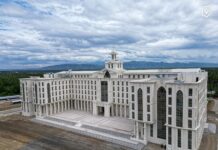THE MIGUEL de Benavides Library will hold the international exhibit, “A Treasure of our Nation,” next year in connection with UST’s quadricentennial anniversary in 2011, featuring books dating back to as early as 1539.
The exhibit will showcase books stored at the Antonio V. del Rosario Heritage section of the library, some of which were donated by the founder of UST the Dominican Miguel de Benavides, the third bishop of Manila
Rector Fr. Rolando de la Rosa, O.P. said the exhibit would serve as a portal to the history of the Filipino nation, which is connected to UST’s own history.
“We hope that, with the enhanced sense of history, Filipinos will learn to appreciate their identity as a people, be grateful to their Spanish roots and learn lessons which they can use to determine their future,” De la Rosa said in his opening remarks during a dinner meeting to plan for the exhibit last April 28.
One of the publications to be included in the exhibit is the Lectura In Legis Et De Allegationibus by juris-consult and writer Rodrigo Juarez. The book talked about the theory of legislature and jurisprudence.
The Polyglot Bible, a fascinating rendition of the Bible in four languages namely Hebrew, Greek, Syriac and Aramaic, will also be displayed. Also known as the “Biblia Regia,” the eight-volume tour de force owes part of its fame to Christopher Plantin, a famous printer of the 16th century. He was able to produce the masterpiece under the patronage of King Philip II of Spain, after whom the Philippines was named.
The collection of historical books once served to support the University in its early days — from the formation of the clergy to the expansion of course offerings.
Gathered during the Spanish era, some of the University’s most precious books were obtained from Jesuit territories. Some of them were from other libraries of the Dominican Order, such as the Colegio de San Juan de Letran in Intramuros, and the Santo Domingo Convent in Quezon City, which suffered from the brutal bombardment during the Japanese invasion. Robin G. Padilla














